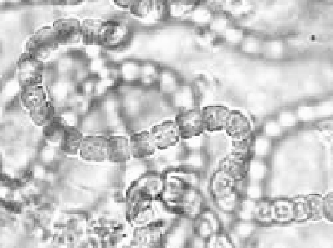Environmental Engineering Reference
In-Depth Information
LYNGBYA HIERONYMUSII
LEMMERMANN
Phylum: Cyanobacteria Class: Cyanophyceae
Order: Oscillatoriales Family: Oscillatoriaceae
Distribution: Europe, Asia, Australia, New Zealand
Habitat: Estuaries and freshwaters
Description: Filaments are solitary and straight normally. They are sometimes
slightly bent and twisted. Loose bundles may also be seen. Many small gas
vacuoles are found scattered in the cell. Trichomes are brownish green to
olive-green. Cells measure 14 µm (width) and 21 µm (length).
Compounds and activities: Extracts of this species have been reported to
enhance antitumor activity from 20 to 45% with an increase in concentra-
tion (Ghazala et al.,
2009).
PHORMIDIUM TENUE
(MENEGHINI) GOMONT, 1892
Phylum: Cyanobacteria Class: Cyanophyceae
Order: Oscillatoriales Family: Phormidiaceae
Distribution: Ireland, Europe, Southwest Asia, Central Asia, Australia,
New Zealand
Habitat: Freshwater habitats
Description: The colonies of this species, which are bright blue-green, form a
leathery mat. The trichome is straight or slightly lexuous, and attenuated
toward the apex. The cells measure 2-5 µm length and 1-2 µm width. The
end cell is long and conical. A thin and gelatinous sheath is present.
Compounds and activities: Several diacylglycerols of this species have been
reported to inhibit chemically induced tumors in test animals. Its phyco-
cyanin has also been reported to inhibit cyclooxygenase-2 (COX-2), which
is overexpressed in breast cancer cells (Singh et al., 2005). Its sulfonic acid-
containing glycolipid protects human lymphoblastoid T cells from the cyto-
pathic effect of HIV infection.
NOSTOC LINCKIA
(ROTH) BORNET, 1880
Phylum: Cyanobacteria
Class: Cyanophyceae
Order: Nostocales
Family: Nostocaceae

